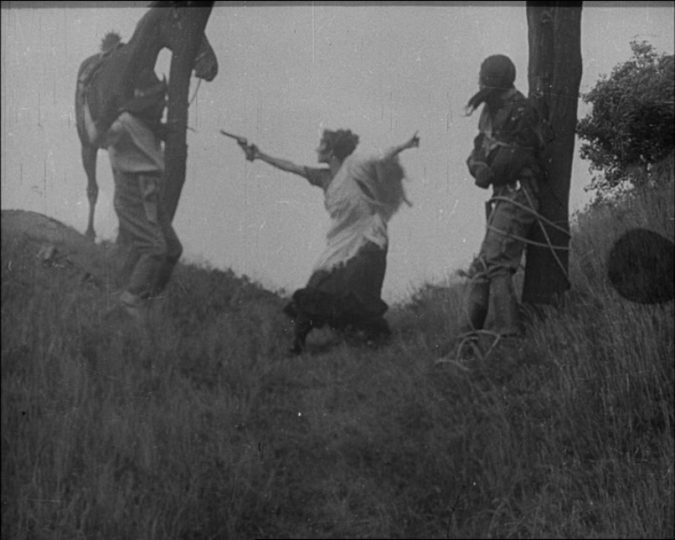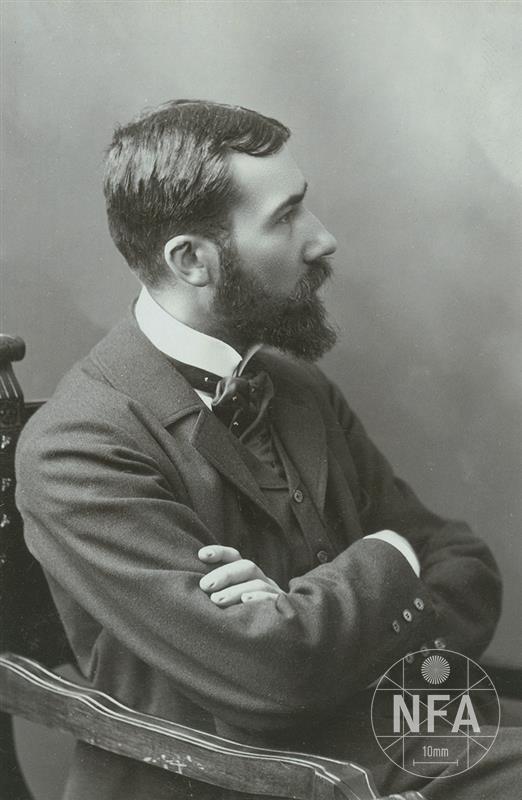Professional film production companies started appearing in Bohemia in the 1910s. They were usually founded by cinema owners who wanted to increase the attractivity of their offer for domestic audiences and gain an advantage over their competition. One exception was a company named Kinofa founded 1st May 1911. The company didn’t have its own cinema so it was forced to adapt to often not unfair distribution conditions. It was founded by Antonín Pech, a pioneer of film business, photographer, director and cinematographer. This year marks the 150th anniversary of his birth.
Antonín Pech was born on 21st October 1874 in Čižice south of Pilsen. After training to be a photographer in České Budějovice, he began working in the photographic studio of his father Adolf Pech (brother of writer Eliška Krásnohorská). By the time he was 25, he became the manager of the J. F. Langhans store in České Budějovice. Its offer included portraits of individuals, machines and buildings as well as group and wedding photographs. For his photographic activities, Pech was received an honorary diploma at an exhibition Tábor and was granted the right to mint a golden medal. But his interest in motion pictures eventually prevailed. He made his first film (that we know of) already during his photographic career in České Budějovice. Titled Satan’s Railway Ride (Satanova jízda po železnici, 1906), it was a short film screened during a fantasy féerie play Satan’s Last Trip (Satanův poslední výlet). There were two versions of the film, the second one was made by Pech’s colleague, architect Jan Kříženecký. A year later, Pech sold his studio and moved to Prague where he invested the money into his own cinema. The cinema named Grand Biograph de Paris in Ječná street opened in 1908. The temporary cinema was set up in the yard of a build from the beginning of the century. Pech later moved it to a more suitable space across the street to a new building named U Čtrnácti svatých pomocníků (The Fourteen Saint Helpers) where Pech lived with his wife Matylda. During the summer, Pech would screen films at Dětský ostrov. He, however, realised that he could utilise his experience with photography not just as an entrepreneur, but also behind the camera.
In order to produce his films, Pech decided to establish “The First Prague Manufactory of Cinematographic Pictures” in a house at Riegrovo nábřeží (today Masarykovo nábřeží) in March 1910. According to a period ad, the new company made “cinematographic pictures timed and scenes for professional theatres as well as scientific and commercial purposes.”[1] The films weren’t screened only in Grand Biograph de Paris, but also in other cinemas in Prague which were interested, for instance in Viktor Ponrepo’s Theatre of Living Photographs (Divadlo živých fotografií).
Pech produced for instance the comedy A Bachelor’s Spring Dream (Jarní sen starého pražského mládence, 1910). The character of the aged philanderer who falls in love with a forester’s niece was portrayed by Josef Křičenský who wrote the story and directed the film. There are likely no preserved copies of the film which was filmed in the Lobkovic garden and near the Kunratice mill. Its production was sponsored by the Bohumil Kovář, the Artistic Director of the Uranie Theatre, who was cast in a smaller role.
Pech’s cinema and production company ceased to exist after he became the technical and commercial director of Kinofa in May 1911. The necessary capital was provided by ironmongery owners Vladimír and Ladislav Rott, café owner Josef Kejř and other Prague entrepreneurs. The list of partners included also František Tichý and Eduard Klejzar who operated several cinemas in Prague (Tichý would later become the owner of rival Illusionfilm). The company seemingly had a market for produced films but, according to available information, not all of them made it into distribution. Kinofa’s production plan was very generous. The company was supposed to produce documentary and live-action films based on important events from the Czech history. The management allegedly signed a contract with the National Theatre to borrow actors, costumes and props. But these ambitious plans failed.
Nevertheless, Kinofa came up with other ambitious projects, such as Rivals (Sokové, 1911), inspired by American Western films. Unfortunately, only fragments are left from the film with huge cast, animals, lavish costumes and epic sceneries. It’s not sure whether the film was screened in cinemas. But Pech was not only the film’s producer but served as its director and cinematographer as well. He held the same positions on Ponrepo’s Illusionism (Ponrepovo kouzelnictví, 1911) which capturers Viktor Ponrepo’s magic performance before a screening in his cinema.
A series of slapstick comedies from 1911 Rudi’s Philandering (Rudi na záletech), Rudi Gets Married (Rudi se žení) and Rudi the Sportsman (Rudi sportsman) had an undeniable potential to attract audiences. The main character, dandy Rudi, portrayed by actor and cabaret artist E. A. Longen, was inspired by French comedian Max Linder. The film was shot in the garden of the U Lhotků pub at the Wenceslas Square and in the streets of Prague, Podolí swimming pool and the Slavia stadium at Letná. But the last two films apparently never made it to distribution.
Criminal drama For the Love of Money (Pro peníze, 1911) written, filmed and directed by Pech, had high artistic ambitions. The story of a robbed farmer was unfortunately found only in uncompiled reels. The cut made in 1953 by National Film Archive can therefore be different from the original intended cut.
After a negligible commercial impact of the aforementioned attempts at live-action film, Kinofa’s focus shifted of newsreels, nature documentaries and films covering sports, science, industry and commercials. In three years, about two hundred were made. For instance Pecha’s three-part report from the 6th annual mass gymnastics event Sokol slet from 1912 was received with great acclaim. His nature documentary St. John’s Rapids (Svatojánské proudy, 1912) received the Exhibition Gold Medal at the 1st International Film Exhibition in Vienna, making it one of the first international achievements of Czech film.
After a short pause, new partners, companies Illusionfilm and Lucernafilm, reinitiated the production of live-action film. The alliance with the latter meant moving the company office from Riegrovo nábřeží to the Lucerna Palace in Vodičkova street Pech was forced to resign as the director of Kinofa but remained in charge of its operation and film production.
He continued to make films, such as the slapstick comedy A Tooth for a Tooth (Zub za zub, 1913) about a sadistic business plan of a dentist’s wife, and humorous romance Man’s Five Senses (Pět smyslů člověka, 1913) based on the script of actor and singer Josef Šváb-Malostranský. Some of the scenes were shot in the Lucerna Palace. Its roof served as the setting for a Faust (1913) adaptation, which was screened with live songs performed by amateur singer Stanislav Hlavsa. It premiered in November 1913 and was the last film made by Kinofa.
Due to increasing costs, commercial failure of live-action films and the lack of capital which resulted in a forfeiture of film copies, Kinofa representatives decided to close the company down in early 1914. Its technical equipment was taken over by Václav Havel’s Lucernafilm. Antonín Pech took a job in the photography department of the City of Prague. In addition to his regular job, he made a living as an assistant photograph to Jan Kříženecký and a laboratory technician in Pragafilm. One of the first Czech film cinematographers, directors and entrepreneurs died on 20th February 1928 in Prague.
Literature:
Jiří Anger (ed.), Digitální Kříženecký. Prague: Národní filmový archiv 2024.
Luboš Bartošek, Dějiny československé kinematografie. Prague: SPN 1979.
Luboš Bartošek, Náš film: Kapitoly z dějin (1896–1945). Prague: Mladá fronta 1985.
Karel Pletzer, Českobudějovické ateliéry 1853–1929. České Budějovice: Jihočeské muzeum 2001.
Zdeněk Štábla, Data a fakta z dějin čs. kinematografie 1896–1945, vol. 1. Prague: Čs. filmový ústav 1988.
Zdeněk Vévoda, The Construction of Space in Czech Fiction Film 1911 – 1918, (Výstavba prostoru v českých fikčních filmech v letech 1911–1918).Diploma Thesis. Olomouc: Palacký University in Olomouc, Faculty of Arts, 2012.
Notes:
[1] Luboš Bartošek, Náš film. Praha: Mladá fronta 1985, p. 37.


